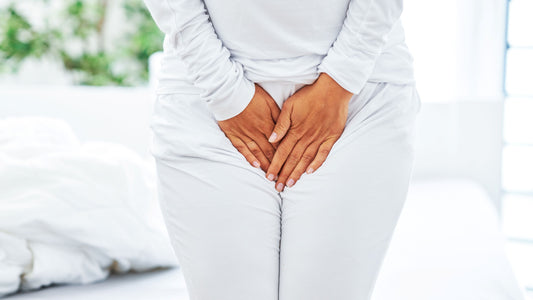Too many women suffer unnecessarily, and even for years.
Vaginal pain. Pelvic pain. It is uncomfortable, annoying or embarrassing to talk about – but I want to change that! I encourage my readers to learn more about vulvar and vaginal health and how to protect and improve their overall pelvic health. This means you also need to feel comfortable talking about your 'V,' especially when seeing your doctor. Well, ok, if not comfortable, at least I will convince you why you need to talk about any issues.
How do you know what “normal” down there is?
In an earlier blog, I covered yeast infections and other vaginal infections. I reviewed what is “normal” for the vulva and vagina and what exactly is happening when a yeast infection comes along (and why we might get one). I also delved into some common bacterial infections and sexually transmitted diseases. There are a lot of preventive measures available to keep these various hazards at bay, including a great DIY anti-yeast infection recipe.
It’s important to always be listening to your body and to be aware of what’s going on with your V. Know the symptoms that should cause you to raise a red flag, and don’t hesitate to engage in an open dialogue with your physician about any problems.
Really, how much should I share with my doctor?
If pain is the issue, it is important that your gynecologist finds out more about what might be causing the discomfort, so it’s essential you are able to help fill in as much background as possible. This holds true for any physical issues you might be having. Think beforehand about all the things you possibly should be discussing with your physician. Use these sample questions to initiate an open and honest conversation during your doctor visit:
- When did the pain start? (This is especially helpful for the doctor to know if you are in menopause.)
- How long have you experienced this pain and is it specific to intercourse or to any other activities? Or does the pain just come intermittently?
- Does the pain occur before, during or after menstruation?
- Is the pain worse at particular times of the day?
- Does anything specific make the pain worse, e.g., having a bowel movement, urinating, exercising, eating, etc.?
- Do you have any other related symptoms, such as urinary or bowel leakage? Do you have lasting constipation and/or difficulty in emptying your bladder?
- Are you experiencing any bleeding, cramping, pressure, heavy or long-lasting periods, or other similar symptoms?
- If you are experiencing cramps, how bad is your cramping and is it associated with birth control pills or other medications?
- Have you exposed yourself to any risk of sexually transmitted disease?
This is not a time to be shy! I’ve had so many women come to me who initially were not candid about their history with vaginal or pelvic pain – until suddenly one day, during a routine exam, out come all the gory details of their past years of misery. Believe me, I know that talking about pain during intercourse can be tough, but it needs to be addressed!
Can we make a pact to stop “powering thru” our pain?
If your physician doesn’t see obvious signs of an infection and feels that hormones or resolvable lifestyle issues are not the root cause of your pain, then it is likely the doctor will want to examine the entire pelvic region more closely.
There are many structures within a woman’s pelvic region that can be a source of pain. Not to worry, however! There are some very easily applied, noninvasive diagnostic tools that physicians can use to help determine what is going on, and most of them are covered by insurance, as long as the symptoms being investigated are related to your pain complaint.
Pelvic Pain: What could it be & how to diagnose it?
Are you suffering from pelvic floor dysfunction? Along with all the other sources for pain in your lady bits and surrounding areas there is a chronic condition that can cause tremendous pain without seemingly having a definitive root cause…and that is chronic pelvic pain. While the root cause for chronic pelvic pain may be identified it is often not; but that doesn’t mean the pain isn’t real.
If you are experiencing pain and your doctor hasn’t been able to isolate the root cause, don’t give up. And note that stressing out about it can potentially make your pain even worse!
In this instance you might even consider seeking out another physician if your initial one is primarily a gynecologist. Not so much as a replacement, but as a partner to your existing physician in your search for your pain’s true source; someone who can better evaluate other organ systems. I always recommend a good functional physician who can look at things from an integrative perspective which includes assessing how your lifestyle and diet, among other things, may be impacting your health.
You might also be struggling with pelvic floor dysfunction. My good friend, Jessica Drummond (MPT, CCH, CHC and Founder and CEO of the Integrative Women’s Health Institute), a women’s physical therapist expert, says that 85% of those diagnosed with chronic pelvic pain also present with musculoskeletal dysfunction.
A physical therapist like Jessica will work with you to determine the status of your pelvic floor muscles, and will teach you the exercises that will best help YOU. Note that while I am a big proponent of Kegels for most women, some actually suffer from a different issue - their pelvic muscles are actually not able to relax because they are too tight.
A physical therapist focused on pelvic health (or your functional doc) will also work with you on your nutrition (remember I said the vagina should be viewed as part of the gut!) and on lifestyle behavior interventions that can support a healthier pelvic floor and a reduction in pain. I have found that maintaining a healthy weight is important to pelvic health, so I recommend women in all of my programs eat a Keto-Green™ diet (which is also supportive of hormone balance and reduced inflammation).
Here’s a fun podcast I did on pelvic health with one of my other favorite women’s health physical therapy experts, Dr. Brianne Grogan, DPT. And try this women’s health physical therapist locator.
In my opinion, the best diagnostic tool to help identify the root cause of pain in the vagina and pelvic region, after an actual physician’s exam and knowing a patient’s overall medical history, is a pelvic ultrasound.
Pelvic Ultrasounds 101

A pelvic ultrasound is an easily performed, noninvasive, procedure that provides your physician quick results about your pelvic organs and surrounding area.
There are two methods that can be done, one is transabdominal (“through the abdomen”) and one is transvaginal (“through the vagina”). The type of procedure that your doctor chooses will be determined based on your symptoms and medical history. Sometimes both procedures may be performed to get all the necessary information.
The transabdominal ultrasound uses a transducer that is placed on the abdomen using conductive gel. The transducer is a device that sends out ultrasound waves at a very high frequency. These waves move through the body, and when they come to an organ or structure within the body the sound waves bounce off the organ and return to the transducer.
The number of sound waves and the speed of the sound waves that return to the transducer provides valuable information about the structure. When the waves return to the transducer they are processed and converted by a computer into images of the various organs and structures being examined by the ultrasound.
The transvaginal ultrasound also uses a transducer, but this one is inserted into the vagina (also using conductive gel).
There is another type of ultrasound that is sometimes used called a Doppler ultrasound. It is a bit different and used to capture the speed and direction of blood flow within certain pelvic organs.
A pelvic ultrasound can identify the position, size and shape of the uterus and ovaries. It can also evaluate changes in bladder shape, the length and thickness of the cervix, the thickness and presence of fluids throughout the pelvic organs and tissues.
In particular, a pelvic ultrasound can help identify some of the most common abnormalities:
- Uterine fibroid tumors - Common, noncancerous and usually not painful. But some can cause pelvic pressure and pain. Some women find that existing fibroid tumors worsen when they have estrogen hormone replacement therapy. You can read about Lisa R’s story, how hormone replacement therapies to address vaginal dryness and pain during intercourse can worsen fibroids. Fibroid tumors can be removed via surgery if necessary. It is obviously also important to rule out cancerous tumors as well, which can be located throughout the pelvic region, including bowel and bladder.
- Ovarian cysts – Common, most just need to be monitored; however, some may need to be removed, especially if they cause pain and/or bleeding.
- Uterine abnormalities such as endometrial conditions. Endometriosis occurs when uterine tissue implants in other locations, causing pelvic pain generally or around the time of the menstrual period.
- Inflammation (Pelvic inflammatory disease/PID) or another infection. A common infection is endometritis, an infection within the uterine lining. There can also be infections in the fallopian tubes. PID can cause significant pain and if not treated can result in permanent damage to the ovaries and fallopian tubes.
- Postmenopausal bleeding with or without pain.
- A variety of pregnancy and fetal related conditions.
Depending on what your ultrasound indicates there may be other procedures that your doctor recommends, including a laparoscopy, colposcopy, or hysteroscopy.
A laparoscopy allows your doctor to look at your pelvic organs using an endoscope that is inserted through the navel into your abdomen. An endoscope is a tiny tube that is fitted with a camera. It can allow your doctor to see your uterus, ovaries and fallopian tubes. You will likely be put under anesthesia of some kind for this procedure. This is a common procedure when women are experiencing ongoing pain that can’t be explained by ultrasound alone.
A colposcopy is a procedure that allows your doctor to look at your vagina, vulva and cervix for signs of disease. Often when a woman has an abnormal Pap test a sample of tissue can be biopsied during a colposcopy for further examination.
A hysteroscopy is often used when there is abnormal bleeding; it allows your doctor to look inside the uterus within the endometrial cavity to see if there are polyps, fibroids or other abnormalities.
But what about other potential causes of vaginal and pelvic pain?
Pain disorders of the vulva and vagina

Many women in my community share their stories with me and it breaks my heart to hear how disruptive vaginal or vulvar pain can be for so many. Not only can these pain disorders impact a woman’s everyday life and activities, they can strip away at her femininity and erode her relationship. Some conditions can be readily resolved with focus and effort; others are much more difficult.
Vulvodynia and Vestibulitis
Women who suffer with vulvodynia live with chronic vulvar rawness, burning, cutting, stinging and pain. The pain can be unprovoked, meaning it often occurs for no apparent reason. Pressure may exacerbate the pain, so intercourse and even sitting may be very uncomfortable or even impossible. This disorder affects up to 10-15% of women who go to their doctor due to vaginal pain. There are many suspected root causes including, pelvic floor muscle weakness and vaginal atrophy, irritation of the pain-sensing nerve fibers in the vulva, trauma, endometriosis, inflammation, and more. It may also be linked to an autoimmune condition; there may be a genetic susceptibility that lends itself to the development of vulvodynia. \
Vestibulitis is one form of vulvodynia. The pain in this condition, however, is specific to the vestibule, which is the tissue surrounding the vaginal opening. Pain can be provoked by a simple touch of clothing and sexual intercourse can be an insurmountable challenge. You might need a women’s health physical therapist to help you learn how to relax the muscles around the vagina’s entrance, as well as working with the therapist to gently stretch the area using vaginal dilators.
You can learn more about vulvodynia and vestibulitis at the National Vulvodynia Association. Another great resource is the Vulval Pain Society. I liked their pre-clinic questionnaire for women to fill out when seeing a doctor about vulvar pain. It is helpful as it might jog your memory about things you’d otherwise forget; especially if you are a bit anxious when visiting the doctor.
Pain from other organs
Due to their proximity to the vagina, the bladder and colon can also come into play when it comes to diagnosing vaginal, vulvar, or pelvic floor related pain. It is important to report colon and bladder related symptoms to your doctor.
Most of us have experienced at least one bout of a bladder infection, which causes burning and irritation when we urinate. But there can also be kidney stones causing pelvic pain, or bladder inflammations such as interstitial cystitis. You don’t want to be self-treating yourself for a yeast infection or bladder infection when it is a kidney stone! I’ve heard from many women about how they hyper-focused on trying numerous vaginal creams and hormone replacement therapy...only to find out they had a bladder issue, sometimes serious. Again, when pain is involved you should be working with your physician to determine what is going on.
Colon issues can run the gamut from irritable bowel syndrome (can feel like it is pain coming from the ovary), constipation, intestinal inflammation (endometriosis can be misdiagnosed), etc. I’ve had several women in my community who were put on hormone replacement therapy to deal with their symptoms, only to find out they had tumors or other issues.
Don’t make assumptions and don’t be shy with sharing your symptoms with a doctor. There’s also no hurt in getting a second opinion if you feel your concerns are not being addressed.
Pain related to vaginal and vulvar tissue conditions
Before I talk about the more common yeast infection and bacterial infections let me just talk briefly about one of the most difficult “vaginal skin” conditions I have treated as a gynecologist, and that is lichen sclerosus.
This condition causes intense itching and makes the vulvar tissues tender and raw; intimacy is often impossible. This condition is related to vaginal atrophy, with 1-2 out of 100 menopausal women experiencing it (although it is becoming more common with younger perimenopausal women as well).
In my experience I have found that improving the hormone health of the vulvar tissues and surrounding deep tissues can help with lichen sclerosus. We’ve had good feedback from women trying Julva who have lichen sclerosus as it can help nourish the skin. It may be worth trying based on the results we’ve seen.
For many women, the root cause of their vaginal and vulvar pain is often due to infections. But sometimes women don’t know something is wrong until it is REALLY wrong (which can mean a lot of pain and potential damage to our delicate lady bits!). That’s why it is important to know your V! So don’t procrastinate! If you are experiencing unexplained symptoms down there, schedule an appointment with your physician today and start getting back to living pain-free!
Bottom line is: You Matter! Your vagina matters! Your pelvic health matters!
Meanwhile, if you’re simply feeling bloated, I have the perfect recipe for you. This easy veggie mix from my new book, “The Hormone Fix,” will keep your digestive system happy while reducing uncomfortable gas and bloating. Eating nutrient-rich, high-fiber foods leads to a stronger and healthier gut.
Roasted Spring Veggies

Serves 4 to 6
Ingredients
- 1 pound assorted spring vegetables (such as carrots, asparagus, radishes, baby summer squashes, spring onions, or sugar snap peas), peeled as necessary and trimmed or cut into bite-sized pieces
- 4 garlic cloves, minced
- 2 tablespoons extra-virgin olive oil
- Salt and pepper
Directions
- Preheat oven to 450° F.
- Line a rimmed baking sheet with parchment paper.
- In a large bowl, combine vegetables, garlic and olive oil. Season with salt and pepper and toss to coat.
- Spread vegetables out in a single layer on baking sheet. Roast for 20 minutes, stir veggies around, then roast an additional 10-15 minutes, until veggies are tender, golden brown, and charred in spots.
- Serve warm or at room temperature.
P.S. If you’re suffering from vaginal dryness...
You need to try Julva – my restorative topical cream for the vulva. Its combination of DHEA and other quality natural ingredients has helped thousands of women physically, mentally and sexually.



